Visit your favourite destinations |
| A Report from birdtours.co.uk |
Southern California: 24th March - 5th April,
Introduction.
My trip to Southern California was a family holiday (although I had the firm intention of seeing as many birds as possible.) California's daylight hours meant that I could get about three hours birding done every morning (from about 5.30 - 9.30), before the rest of the family got up.) I also arranged to meet two California based birders, Garry George and Mary Beth Stowe who joined me for a day and two half days respectively.
Garry is a gentleman birder and big world lister, he arrived at our rendezvous with a hamper of food and a flask of tea especially me. Great fun to be with, he was determined to help me to as many lifers as possible and with his help I saw among others, Le Conte's Thrasher, Burrowing Owl and Prairie Falcon, none of which I was to see again. He is a keen conservationist, and at the time of writing is engaged in a battle to save the endangered California Gnatcatcher.
Mary Beth is a skilled field birder, and has a fantastic knowledge of San Diego birds. She met both of my key criteria for a good birder, firstly she could pick up all the birds by ear and secondly she could identify gulls in immature plumages! (I hadn't had sufficient time to revise these prior to my trip and so I was treated to a master class at La Jolla sea front.) Mary Beth cleared up all of the rocky shore birds for me in one morning, found me a pair of California Gnatcatcher and capped it all by finding a singing Gray Vireo. I had my first genuine American "high five" after this.
Between the two, they greatly increased my list and I am deeply grateful to them both. In the end I saw 178 species of which 99 were lifers, a total that I was very pleased with.
The family stayed in two centres; the first week was at Silver Lakes Resort, Helendale in the Western Mojave and the next six days were at Sand Pebbles, Solana Beach, just north of San Diego.
Itinerary
23rd March: We arrived late, were unable to reach
our accommodation in time for check in and ended up staying in a Best Western
Motel in Victorville.
24th March: Bird the golf course at Victorville, Check in at Silver Lakes,
visit Calico Ghost Town
25th March: Bird Silver Lakes at first light, spend rest of day at Disneyland.
(Birding lowlight of whole trip!)
26th March: Try to bird Mojave Narrows Regional Park in morning. A burst
tyre caused by my attempt to enter via the exit before the gate opened (and
failing to notice the spikes in the road) ruled out all birding except what
I could see from the broken down car). Afternoon at Great Bear Lake after changing
the car in Ontario.
27th March: Bird Rockview Nature Park, Victorville and Mojave Narrows
Regional Park in the morning. Visit the San Bernardino Mountains in the afternoon.
28th March: Full day birding with Garry George at Carrizo Plains and
The Pinos Mountains.
29th March: San Jacinto State Park (via Aerial Tramway) (Near Palm Springs)
30th March: The Living Desert Zoo and Museum, Desert Springs. (Near Palm
Springs) Move to second Centre near San Diego.
31st March: Bird San Elijo Lagoons (Solana Beach) at first light. Spend
rest of day at San Diego Zoo.
1st April: Morning with Mary Beth Stowe at Sunset Cliffs, La Jolla and
Lake Hodges. Afternoon at the Birch Aquarium at Scripp's Institute.
2nd April: Morning at Tijuana Slough National Wildlife Refuge, Imperial
Beach and San Diego River Mouth.
3rd April: Morning with Mary Beth at Mission Trail Regional Park, Cibbets
Flat and the Pacific Crest Trial. Afternoon at Sea World.
4th April: Morning at Point Loma, and Fort Rosecrans National Cemetery.
Rest of the day in the Palomar Mountains. (Telescope and State Park)
5th April: Early morning at Point Loma / Fort Rosecrans (again) in desperate
final attempt to improve list one more time! Fly from LAX in afternoon.
The sites (in chronological order)
and commentary.
All directions (unless otherwise given) can be found in the excellent ABA Guide,
"Where to watch birds in Southern California" by Brad Shram.
Victorville, Best Western
Big Tree Motel, Golf Course:
Woke up at first light wondering what would be my first American bird of the trip. Opened the patio doors to the all too familiar sounds of House Sparrow and Starling. The croak of a Raven was familiar, but unexpected, and was to be the first of many.
Key birds: Housefinch, Lesser Goldfinch, Brewers Blackbird, White-crowned Sparrow, Black Phoebe, Coopers hawk and a couple of California Gull. All were to become familiar sights over the next few days.
|
Silverlakes, Helendale: Man made Silverlakes provided some excellent bird watching. |
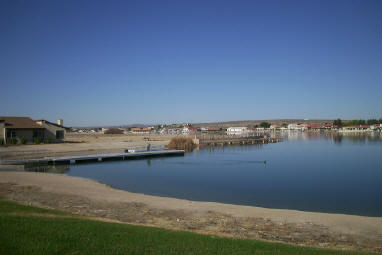 |
Situated in the Western Mojave Desert, a pair of large man made lakes in the centre of the resort seemed a little incongruous; however they provided me with some good birding. This quantity of water in the middle of a desert must always be attractive to birds and deserves to attract the attention of more birders. Many of the birds that I saw were obvious migrants. During my weeks stay, I saw no other birders.
Key birds:
2 California Quail (L), 400+ American Coot, 50+ Bufflehead, 10+ Northern Shoveler,
10 Pied-billed Grebe, 10+ Horned Lark, 6 California Gull, 1 Ringed-billed Gull,
1 Says Phoebe (L), Raven, 2 Common Yellow-throat, 2 Mourning Dove, 1 Canvasback,
5+ Eared Grebe, 2 Turkey Vulture, 20+ Brewers Blackbird, 6 American Robin (L),
8 Double Crested Cormorant, 1 Black-necked Stilt, 6 Great-tailed Grackle (L),
1 Yellow-headed Blackbird (L), 2 Lesser Scaup, 50+ Ruddy Duck, 2 Yellow-rumped
Warbler (L), House Finch (lots), 40+ White Crowned Sparrow, 1 Tree Swallow (L),
1 Hooded Merganser (L), 2 Least Sandpiper, 5 Cinnamon Teal, 2 American Wigeon,
1 Hooded Merganser, 2 Least Sandpiper
Disneyland; the big queue!
Perhaps the less said the better, and I carried binoculars all day!
Birds: House Sparrow, Starling, American Crow, Mallard, American Coot,
Rock Dove
|
Mojave Narrows Regional Park: Lots of different habitats in a small area, it had a big bird list and I feel sure that there was a lot more to see here given time. |
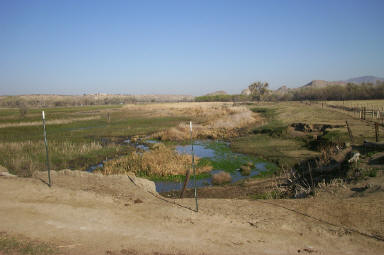 |
A large area of fishing lakes, wetland, grassland and woodland three miles south of Victorville. On my first visit a burst tyre ruled out all birding except what I could see from broken down car. I shouldn't have tried to drive into the exit. I returned again the next day for some real birding.
Key Birds:
1 Red-tailed Hawk, 2 Western Bluebird (L), 10 Double-crested Cormorant, American
Coot (100's), Bufflehead, 2 Nuttall's Woodpecker (L), 2 Northern Flicker, 1
Osprey, 1 Accipiter Sp. (Sharp-shinned?), Great-tailed Grackles, 20 White Pelicans,
1 Common Moorhen, 1 Snowy Egret, 1 Great White Egret, 2 Western Kingbird (L),
4 Bushtit (L), 2 Black-throated Sparrow (L), 6 Savannah Sparrow (L), 1 Common
Snipe, 1 Greater Yellowlegs, 3 Cinnamon Teal (L), 1 Black Phoebe, 3 Turkey Vulture,
2 Coopers Hawk, 1 Yellow-rumped Warbler, 10 American Goldfinch (L), 4 Kildeer,
8 California Quail, 150 Red-winged Blackbirds
|
Rockview Nature Park, Victorville. Rockview had a lot of birding potential but my stay was short. |
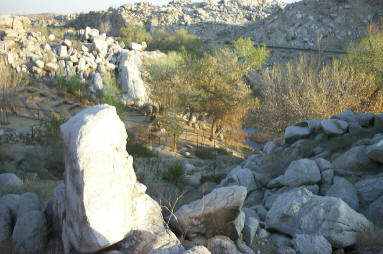 |
Rockview was closed throughout my stay, but was easily accessible by walking round the gate. Situated just north of town on the banks of the Mojave river.
Key birds:
Red-winged Blackbird, 1 Ruby-crowned Kinglet (L), 3 White Throated Swift (L),
10+ White Crowned Sparrow. Plus other birds that "got away"
|
Great Bear Lake and the San Bernardino Mountains: The forest walk near the discovery centre gave us stunning views of jays and woodpeckers. We saw several Acorn woodpecker larder trees. |
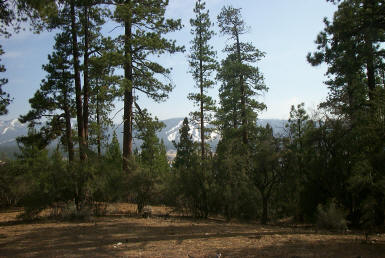 |
We did a whistle stop tour of the lake in the afternoon (after exchanging my car). The next afternoon we visited the nearby Forest Discovery Centre. The bird table here gave me three lifers.
Key birds:
500+ American Coot, 8 Gadwall, Mallard, 20+ White Pelican, Pied-billed Grebe,
2 Redhead (L), 2 Great-blue Heron, Brewers Blackbird (lots), American Robin,
1 Acorn Woodpecker (L), 2 Common Merganser, Gull Sp. (many distant birds remained
unspeciated), 4 Steller's Jay (L), 3 Western Bluebird, 8 Western Scrub Jay (L),
2 Dark-eyed Junco, 6 Pigmy Nuthatch (L), 10 Mountain Chickadee (L), 3 Spotted
Towhee(L) 4 Violet Green Swallow (L), 3 Acorn Woodpecker, Northern Flicker,
Red-tailed Hawk, House Finch.
|
Maricopa, Carrizo Plains and the Pinos Mountains: The picture shows a rare Pronghorn Antelope on the Carrizo plains, the line of the San Andreas Dault can be seen in the background. |
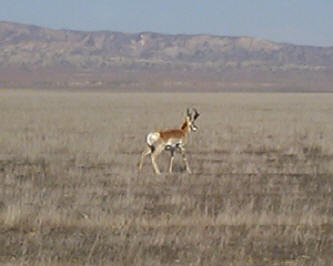 |
On Thursday 25th March I spent full day birding with Garry George at Maricopa, The Carrizo Plains and The Pinos Mountains. We had arranged to meet, via the Internet, two weeks previously. I was to drive out to Gorman for 6am in the morning, (Across miles of unlit desert dirt road - my GPS and laptop guided me with unerring accuracy, fortunately). Garry was to drive up from LA. My attempts to liaise with Garry in California were thwarted by poor telecommunications in the desert and, unbeknown to me, the fact that Garry was stuck in Florida. I left multiple messages on his answering machines and hoped for the best!
Remarkably it all came together, Garry arrived at about 6.15am and we got on the way. First stop was to be Maricopa, a known Le Conte's Thrasher stake out and a bird that Garry was insistent that I should see. (He taught me a lot about prioritising the near endemic species of California, something that I hadn't really considered prior to my visit, reasoning that any tick was a good tick.)
Garry had brought a tape for this one. (Part of his world lister kit!). The first bird to show was Sage sparrow, soon to be followed by a Le Conte's. An excellent start to the day.
We then drove into the Carrizo Plains, our first stop was for a distant soaring raptor that turned out to be a Rough-legged Hawk. After several more featureless miles we came upon an abandoned ranch, with a birder watching it! It turned out that he was on to a sizable flock of Tri-Colored Blackbirds (another near endemic to California.) Driving on, we stumbled across a single Burrowing Owl, a bird that I had been hoping to see. The plains were bone dry and the Great Soda Lake didn't look as though it had seen water for years therefore a single Whimbrel and two American Avocets were both unexpected additions.
We continued on, into the southern approaches to the Central Valley in the hope of seeing Yellow-billed Magpie, but without success. We did chance across a big flock of mixed Cliff and Northern Rough-winged Swallows, both ticks for me.
On our return through the Carrizo we stumbled across an enormous flock of Long-billed Curlew. (about 3000 of them.) We stopped at this point and enjoyed Garry's food hamper whilst gazing awestruck at the wheeling mass of birds.
An attempt to see Mountain Plover failed, I think they had departed, but we did manage to pick out a feeding Prairie Falcon on the ground which later flew off giving good views.
We decided to travel back through the Pinos Mountains and were to be rewarded with several good birds: Golden Eagle, Phainopepla and Band-tailed Pigeon amongst others.
Garry and I parted company, over a flask of tea as the sun set at Gorman. It was a day that I will long remember.
Key birds:
Maricopa area: 2 Sage Sparrow (L), 1 Western Meadowlark (L), 1 Le Conte's
Thrasher (L), White Crowned Sparrow
Carrizo Plains: 1 Rough-legged Hawk, 1 Say's Phoebe, Western Meadowlark (Numerous), Western Kingbird (Numerous), Savannah Sparrow, Horned Lark (Numerous), 4 Red-tailed Hawks, White Crowned Sparrow, Brewers Blackbird, 20 Tri-colored Blackbird (L), 1 Lark Sparrow (L), 1 Burrowing Owl (L), 1 Yellow-rumped Warbler, 2 American Avocet, 6 Whimbrel, c.3000 Long-billed Curlew (L), 1 Turkey Vulture, Raven, 1 Prairie Falcon (L)
Road towards Central Valley, NW of Carrizo Plains: Red-winged Blackbird, 15 California Quail, 100+ Cliff Swallow (L), 4 Northern Rough-winged Swallow (L), 1 Oak Titmouse (L), House Finch, Red Tailed Hawk
Pinos Mountain Road. (Numerous stops): Dark-eyed Junco, 1 Phainopepla (L), 2 Golden Eagle, 1 Merlin, House Finch, 1 California Thrasher (L), Mountain Chickadee, Pigmy Nuthatch, Lark Sparrow, Spotted Towhee, California Towhee (L), Band-tailed Pigeon (L), Northern Flicker, Western Scrub Jay, Western Bluebird, American Robin, Steller's Jay
|
San Jacinto State Park - Palm Springs. (via Aerial Tramway) The view from near the summit of Mount Jacinto, looking down on Palm Springs |
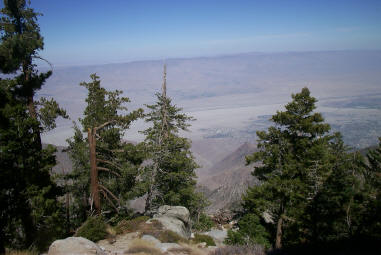 |
Our visit to Palm Springs was primarily to see the San Jacinto Moutains. I was fascinated by the vast array of wind turbines on the northern approach road (this was the physics teacher in me) and appalled at the extravagant water use (I also teach environmental science) We had intended to see the Living Desert Zoo the same day, but ended up being so captivated by the Mountains that we did an extended summit walk and left the zoo for later.
Key birds:
Top of Tramway: 2700m elevation: 3 Clarke's Nutcracker (L), 1 White-headed Woodpecker
(L), 2 Hairy Woodpecker, 4 Crossbill, Western Bluebird, Steller's Jay, Pigmy
Nuthatch, Mountain Chickadee, 6 Dark-eyed Junco, Raven, House Finch, 1 Rock
Wren (in car park area)
|
The Living Desert Zoo and Museum, Desert Springs: The Cactii Gardens at the Living Desert were especially attractive to Cactus Wrens |
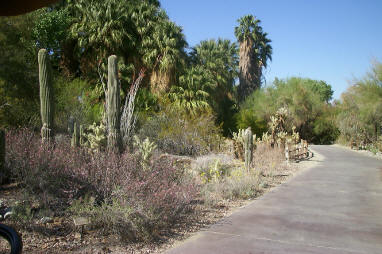 |
We decided to stop in at the Living Desert Zoo on the day that we moved from Helendale to San Diego. It was a good decision; The zoo was great and I got four lifers there that I wasn't to see anywhere else!
Key birds:
1 Black-tailed Gnatcatcher (Car Park) (L), 3 Yellow-rumped Warbler, 10+ Cactus
Wrens (L), 2 Verdin (L), 3 Costa's Hummingbird (L), 5 Gambel's Quail (L), 4
Northern Mockingbird, 6 White-crowned Sparrow, Mourning Dove, House Sparrow
and a tantalising glimpse of what was almost certainly a Roadrunner jumping
off the fence at the back of one of the compounds. (I never did see one for
certain)
San Elijo Lagoons, Solana
Beach:
Situated just a mile north of my apartment, San Elijo Lagoons proved to be an excellent stop for some early morning birding. This is a known site for California Gnatcatcher but I failed to see one here.
Key birds:
Savannah Sparrow, 3 California Towhee, 2 Marsh Wren (L), 10 Anna's Hummingbird
(L), 4 Snowy Egret, 6 Blue-winged Teal, 8 Cinnamon Teal, 2 American Wigeon,
6 American Avocet, 4 Kildeer, 3 Semi-palmated Plover (L), c.200 Western Sandpiper,
1 Marbled Godwit (L), 2 Willet, 1 Grey Plover, 3 Dowitcher sp., 4 Lesser Yellowlegs,
3 Double-crested Cormorant, 1 Loggerhead Shrike, 3 Northern Mockingbird, 12
Elegant Tern (L), 2 Caspian Tern, 1 Golden-crowned Sparrow (L), 3 Pacific Coast
Flyctcher (L), 100+ American Coot, Northern Shoveller, 1 Black Phoebe, 2 Californian
Thrasher.
San Diego Zoo:
Billed as the worlds best Zoo, this was a must visit destination for the family.
A report on the internet suggested that binoculars should be worn here, if only
for the aviaries. In the end I spent more time looking at birds in bushes than
I did at the animals.
Key birds:
Anna's Hummingbird (lots), 1 Hooded Oriole (L), 1 Townsend's Warbler (L), 3
Californian Towhee, 4 Housefinch, 1 Coopers Hawk, Northern Mockingbird, Mourning
Dove, Great Blue Heron, Mallard, House Sparrow, Western Gull (Car park) (L)
|
Pacific Coast (Sunset Cliffs and La Jolla) and Lake Hodges: My first real look at the ocean was at Sunset Cliffs. The gulls (This one is Western) behaved very well. |
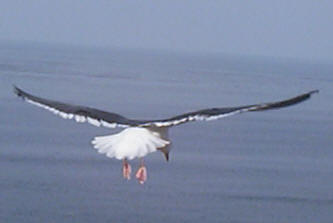 |
The other of my internet connections was Mary Beth Stowe. I had gathered from her regular postings to CALBIRDS that she spent a great deal of time out in the field and that she knew the birds of the area intimately. Mary Beth had taken a list of my target species and was keen to help me see them.
By the time we met, I had knocked off most of the easy species, but I hadn't yet looked for the shorebirds. Mary Beth knew exactly where to go. She picked me up at 6.00 am (my first lie in of the holiday!), insisted on driving, and took me down to Sunset Cliffs.
New birds came thick and fast. A large flock of Western Grebe had just one Clark's Grebe in it. A flock of Black Turnstone flew by. A nice group of Brandt's Cormorant's sat on a rock promontory. Heerman's Gulls proved to be easy to see. Glaucous-winged was looking difficult until Mary Beth picked one up in a fly by flock. I was most impressed.
Still needing a few targets, we headed up to La Jolla. A search of the many Cormorants eventually gave us Pelagic. In the process, lots of passerines called from the cliff top vegetation and Mary Beth knew every squeak, Wrentits, Orange -crowned Warbler, Bushtit etc….Mary Beth pished most of them out for me. Walking south, I was treated to a master class of Gull identification, including a particularly pale Glaucous-winged Gull. A hoped for flock of Surfbirds put in an appearance and finally a lone Wandering Tattler was seen on the rocks of the small harbour. A couple of spotted Sandpiper lead to an interesting discussion about Common v. Spotted Sandpiper ID.
Mary Beth suddenly stopped. "Stupid Cowbird up there" she muttered. Clearly no love lost here, but I needed Brown-headed Cowbird, and if this was one then I wanted to see it! After some effort Mary Beth picked it up, silhouetted at the top of a large tree.
Time for one more stop, and with most of my coastal species now seen, we headed for Lake Hodges to try for California Gnatcatcher. Cassin's Kingbird was our first new bird and soon we were able to compare them with the similar Western. Mary-Beth also picked out calling Bewick's Wren and Wren Tit both of which I needed. We scoped the parched lake through the heat haze. There were several species of wader, a couple of Osprey's and, better still, a single White-faced Ibis. "The" Gnatcatcher called from a nearby bush and we were able to get good views of both male and female. Mission accomplished!!
Spent the rest of the day at the Scripp's Aquarium with my family.
Key birds:
Sunset Cliffs: c.100 Western Grebe (L), 1 Clarke's Grebe (L), 20 Brown
Pelicans, 1 Red-throated Diver, 15 Black Turnstone (L), Ruddy Turnstone, Double-crested
Cormorant, 10 Brandt's Cormorants (L), 20+ Heerman's Gull (L), 1 Glaucous-winged
Gull (L), Western Gull (lots), 1 Willet, 1 Whimbrel, 1 Least Sandpiper
La Jolla Sea Front: Brown Pelicans, 1 Black Turnstone, Ruddy Turnstone, Double-crested Cormorant, 10 Brandt's Cormorants, 4 Bushtit, 1 Orange-crowned Warbler (L), 1 Pelagic Cormorant(L), 30+ Heerman's Gull, 1 Glaucous-winged Gull, Western Gull (lots), 2 Spotted Sandpiper, 18 Surfbirds (L), 1 Wandering Tattler (L), 2 Willet, 1 Brown-headed (or Stupid) Cowbird (L), 100+ California Sea Lions / Seals
Lake Hodges: 6 California Towhee, 4 White-crowned Sparrow, 4 Northern Rough-winged Swallow, 1 Cliff Swallow, 6 Barn Swallow, Bushtit, 6 Cassin's Kingbird (L), 4 Western Kingbird, 1 Bewick's Wren (L), 2 California Gnatcatcher (L), 2 Osprey, 6 American Avocet, 1 White-faced Ibis (L), Wrentit (L), White Pelican, Snowy Egret, Great-white Egret, American Coot, Western Grebe
Tijuana Slough / Imperial Beach
/ San Diego River Mouth:
Mary Beth had suggested that Tijuana Slough might be a good bet for Clapper Rail. My book suggested that high tide would be best. On arrival, the tide was clearly out, and the reserve didn't look very exciting. However the sea was another story, I have never seen so many Divers (Loons) in one place. I walked all the way down to the Tijuana River mouth watching the sea all the way. On my way back I called in briefly at Imperial Beach and the San Diego River Mouth (off Sea World Drive). Both were very worthwhile.
Key birds:
Tijuana Slough National Wildlife Refuge: 200+ Brown Pelican, 4 Black-vented
Shearwater (L), 100+ Red-throated Diver, 6 Great Northern Diver, 4 Pacific Diver
(L), 1000+ Western Grebe, 1-2 Clarke's Grebe, Western Gull (numerous), Heerman's
Gull (numerous), 100+ Elegant Tern, 1 Arctic Skua, 1 Common Tern, 4 Forsters
Tern, 2 Caspian Tern, Double Crested Cormorant, Brandt's Cormorant, 1 Pelagic
Cormorant, 4 Snowy Plover, 2 Grey Plover, 50+ Willet, Snowy Egret, American
Wigeon, 2 Lesser Scaup, Wimbrel, 1 Red-breasted Merganser, 20+ American Avocet
Imperial Beach: 8 Surf Scoter, 200+ Willet, 1 Pacific Diver
San Diego River Mouth: 3 Little Blue Heron, 100+ Bonaparte's Gull, 2 Forster's Tern, 50+ Dowitcher Sp (both present), 200+ Western Sandpiper, 2 Dunlin, 2 Northern Pintail, 30 Brant, 4 White Pelican, American Avocet.
Mission Trail regional Park,
Cibbets Flat and the Pacific Crest Trial:
This was my second half day out with Mary Beth Stowe. The aim was to see some of the Riparian Woodland species still missing from my list. Mary Beth also secretly intended that I shouldn't leave California without seeing Gray Vireo, a really good bird for California, and one that I hadn't really considered a possibility.
Mission Trails was superb habitat and we saw lots. I amused MB by referring to "Bonnie little Birds". She confused me by saying "there's somebody in that bush" The joys of a common language! Among the highlights were Chipping Sparrow, Black-headed Grosbeak, Red-shouldered Hawk, Rufous-crowned Sparrow, Black-throated Gray warbler and another "stupid" Cowbird. A canyon wren called in the distance but eluded us.
Cibbets Flat was one of several stops in the Laguna Mountains. Two Hutton's Vireos chased off a Western Scrub Jay giving tantalisingly poor views against the light of the sun. Oak Titmouse performed rather better.
The Pacific Crest Tail was MB's last attempt to find the Gray Vireo. Almost as soon as we left the car MB picked one up singing in the far distance. We walked towards the song but it soon became clear that the bird was some way from the trail. Out came the tape. The Vireo went quite, I suggested that we might have scared it away, but MB had confidence. Sure enough the bird crept closer and closer and we had superb views, it even flowed us down the path as we made our return. Mary Beth offered me a "high five." (I've seen these in the films so I knew what to do!!!) Nice one Mary Beth. Another fantastic half days birding.
Key birds:
Mission Trails: 4 Orange-crowned Warbler, Nuttall's Woodpecker, Barn
Swallow, Tree Swallow, Northern-rough Winged Swallow, 1 Chipping Sparrow (L),
2 Black-headed Grosbeak(L), 1 Red-shouldered Hawk (L), 1 Rufous-crowned Sparrow
(L), 1 Black-throated Gray warbler (L), 6 Lesser Goldfinch, California Towhee,
Spotted Towhee, Yellow-rumped Warbler, Bushtit, 1 Hermit Thrush, 1 American
Kestrel, Anna's Hummingbird, Wrentit, Western Meadowlark, Western Scrub Jay,
1 Pacific-slope Flycatcher, 1 Black Phoebe, Dark-eyed junco, 1 Brown-headed
Cowbird, 1 Bullock's Oriole (L)
Cibbets Flat (Laguna Mountains): 1 Red-tailed Hawk, 4 Oak Titmouse, 2 Hutton's Vireo (L), 1 Steller's Jay, 2 Western Scrub Jay, 2 Nuttall's Woodpecker, 1 Hermit Thrush
Pacific Crest Tail: 1 Gray Vireo (L) (Picked up on song by Mary Beth and then taped out into the open)
|
Point Loma / Fort Rosecrans National Cemetery A flowering Agave just outside Point Loma Lighthouse was very attractive to a Bullocks Oriole and several Hummingbirds. |
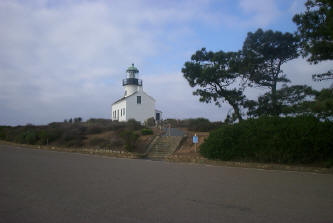 |
On my second to last morning I decided to visit the migration hotspots of Point Loma and Fort Rosecrans. I was so impressed that I went there the next day too. There were a lot of birds about, so I guess that there had been reasonably sized falls on both days. Surprisingly there were no other birders to be seen. At first I was overwhelmed by the variety and wished that I had Mary Beth to help me out. In the event I quickly got into my stride, some calls were becoming familiar, and I soon picked up four new lifers, Rufous Hummingbird, Western Tanager, Fox Sparrow and Wilson's Warbler.
| Fort Rosecrans is a National Cemetery, and I confess to feeling a little uneasy about birding my way around it. I was later informed by a local that the authorities "knew the score" and were quite relaxed about birders. |
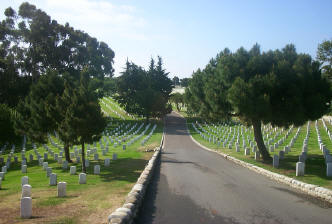 |
On my second visit I picked up one of the Empidomax Flycatchers at Fort Rosecrans but really didn't know which it was, I thought Gray, but these are well out of their range in California. Fortunately I was to bump into a local birder, Peter Ginsberg, whom I was later to take back and relocate the Flycatcher. After due consideration he pronounced it to be Hammond's. This was to be my last "tick" of the trip, finishing, frustratingly, on 99 lifer's and a pleasing 178 species for the trip.
Key birds: Totals for two trips.
Pt. Loma/ Cabrillo: 20+ Orange-crowned Warblers, 20+ House Finch, 5 California
Thrasher, 3 Spotted Towhee, 20+ California Towhee, 5+ Rufous Hummingbird (L),
1 Western Tanager(L), 1 Bullocks Oriole, 6 Fox Sparrow (L), 1 Wilsons Warbler
(L), 20+ Anna's Hummingbird, 15+ Yellow-rumped Warbler, 3 Hermit Thrush, 15+
White-crowned Sparrow, 8 Golden-crowned Sparrow, 30+ Bushtit, 4 Wrentit, 1 Pacific-slope
Flycatcher, 10 Cedar Waxwing (Overflying)
Fort Rosecrans: 70+ Yellow-rumped Warbler, 30+
Bushtit, 5 Pacific-slope Flycatcher, 1 Hooded Oriole, 1 Western Tanager, 2 Black-headed
Grosbeak, 20+ Dark-eyed Junco, 5 Black Pheobe, 30+ Assorted Hummingbirds, 20
Cassins Kingbird, 1+ Western Kingbird
1 Hammond's Flycatcher (L), 2 Hooded Oriole, 20+ California Towhee, 4 California
Thrasher, 40+ White-crowned Sparrow, 40+ Orange-crowned Warbler, 3 Red-shafted
Northern Flicker, 2 Coopers Hawk, 4 Chipping Sparrow
|
Palomar Mountain: The open fields around the big telescope were alive with Western Scrub Jays and Bluebirds. |
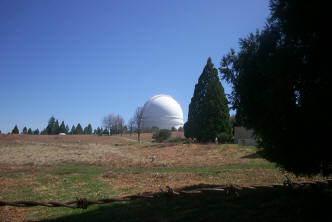 |
My last full day was to be spent at Palomar Mountain. I had wanted to see the giant telescope since I was a kid. After looking at this (one of the few free attractions in California) we went to the State Park and had a last mountain walk. Mary Beth had recommended "Mothers Kitchen" a Mountain Cabin Restaurant situated near the summit. We stopped for lunch, which proved to be really good home cooking and highly recommended.
Key birds: 30+ Steller's Jay, 20+ Mountain Bluebird, 10+ Western Scrub Jay, 20 Band-tailed Pigeon, 5 Mountain Chickadee, Raven, 4 Acorn Woodpecker, 4 Mountain Quail (L), 30+ Violet-green Swallows.
Bibliography:
"Where to watch birds in Southern California" . - Absolutely essential.
 |
The Sibley Guide to Birds (Audubon Society Nature
Guides Ser.)
|
Why not send us a report, or an update to one of your current reports?